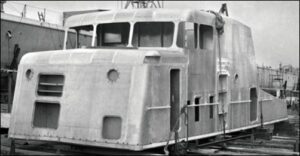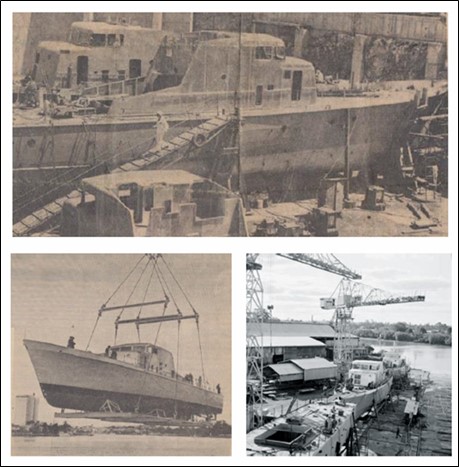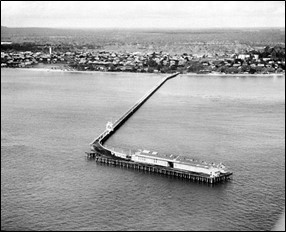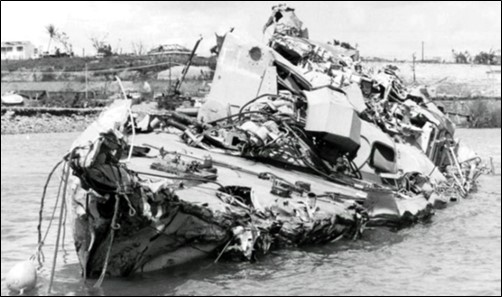The following is an article from”All Hands” December 2017 edition of the Australian Maritime Museum Volunteers’ Quarterly Newsletter.
By Wal Robson
The museum’s popular patrol boat has a significant birthday coming up next month. A volunteer who helped build her tells her story.

Design
An Attack-class patrol boat of the Royal Australian Navy, HMAS Advance (83) was constructed during 1967 and commissioned into the RAN in 1968. She operated from Darwin and patrolled northern Australian waters for more than a decade, before becoming both a TV star and a training ship. After being decommissioned on 6 February 1988, Advance was transferred to the ANMM, where she remains. As records show that HMAS Advance was officially commissioned on 24 January 1968, she will turn 50 on 24 January 2018.
The patrol boats had a displacement of 100 tons at standard load and 146 tons at full load, were 107.6 feet (32.8m) in length overall, had a beam of 20 feet (6.1m), and draughts of 6.4 feet (2.0m) at standard load, and 7.3 feet (2.2m) at full load.
Propulsion machinery consisted of two 16-cylinder Paxman YJCM diesel engines, which supplied 3460 shaft horsepower (2580kW) to the two propellers. The vessels could achieve a top speed of 24 knots (44km/h; 28mph), and had a range of 1200 nautical miles (2200km; 1400mi) at 13 knots (24km/h; 15mph). The ship’s company consisted of three officers and 16 sailors.
Main armament was a bow-mounted Bofors 40mm gun, supplemented by a .50 calibre M2 Browning machine gun and various small arms. The ships were designed with as many commercial components as possible. The Attacks were to operate in remote regions of Australia and New Guinea, and a town’s hardware store would be more accessible than home base in a mechanical emergency.
Construction
The patrol boats were built using an “assembly-line, prefabrication” method, where seven major sections plus the funnel were built by Commonwealth Engineering at their workshops in Rocklea (a suburb of Brisbane). Commonwealth Engineering decided on the “section” plan because the individual sections fitted easily into their rust-blasting and painting tunnel, and because of transport requirements to the Brisbane shipyard of Evans Deakin and to Walkers Pty Ltd in Maryborough. (Ten boats were assembled and fitted out by each of those shipyards; HMAS Advance was laid down at the Maryborough operation in March 1967.)
Before fit-out of the superstructure (pictured below) could start, a full-size timber model was made in a Brisbane workshop, and all the required equipment was fixed in place to ensure it would fit and be accessible. Once this was completed, final drawings were made and these were used by both shipyards for final fitting out.

During construction of the first boat, HMAS Attack, in Brisbane, the weight of every piece of equipment taken on board and any removed was recorded. The person given this task took his job very seriously. Unfortunately, this resulted in many misunderstandings, especially when a large item such as engine cooling piping was taken on board to check if it fitted and then taken back to the workshop for adjustment. Regardless of size, the weight of everything was recorded going aboard and again if it came off.
Assembly and launch
The shipyards used different assembly and launching techniques. Evans Deakin assembled their boats in a “dry dock” situation (below) and launched them by crane at any convenient time (bottom left). Walkers assembled and launched their boats on a conventional slipway (bottom right). Because the shipyard in Maryborough was on the Mary River which was affected by the rise and fall of the tide, some launches were conducted at night to coincide with the high tide.
HMAS Advance, for instance, was launched at 8pm on Wednesday, 16 August 1967, by Mrs F.L. George, wife of Rear-Admiral George of the RAN. Following fit-out, sea trials were conducted in Hervey Bay on 16 January 1968. Due to tidal conditions the boat left the shipyard very early in the morning to travel more than 50 kilometres down the Mary River to reach the bay.

Following the trials, if all was successful or only minor adjustments were necessary, the boat would berth at the Urangan Pier until it was handed over to the Navy and formally commissioned.

It is recorded in the book Ship Building at Walkers Limited: Maryborough, Qld, compiled by J.A. Concannon, HMAS Advance was handed over to the Navy on the same day as the sea trials 16 January 1968. The handing-over process consisted of a team of naval overseers accepting the boat on behalf of the Navy. The Navy then prepared for the formal commissioning. This took place at the historic Urangan Pier (pictured right) on 24 January 1968.
Advance’s operational history
Advance operated out of HMAS Coonawarra in Darwin, Northern Territory, between 1968 and 1980. As well as the standard duties for her class, Advance was also used for surveillance, search-and-rescue, and hydrographic survey (in company with the survey ship HMAS Moresby).
- During 1968, Advance and sister ship Attack shadowed the Soviet trawler Van Gogh, which operated in the Gulf of Carpentaria for two months.
- Advance and three other patrol boats were in Darwin Harbour on 25 December 1974, when Cyclone Tracy hit. Advance and Assail managed to escape serious damage, but Attack was forced aground and suffered hull damage, and Arrow collided with Stokes Hill Wharf and sank. (See picture on following page.)
- During 1975 and 1976, Advance regularly operated as part of Operation Trochus: a concentrated effort to respond to illegal fishing vessels in northern Australian waters.
- From late 1977, Advance was assigned to HMAS Waterhen in Sydney for patrols along Australia’s eastern coast but was redeployed elsewhere when necessary.
- In 1979, Advance was one of two Attack-class vessels used to portray the fictional HMAS Ambush, setting of the ABC television series Patrol Boat.
- Following her replacement by a Fremantle-class patrol boat in 1980, Advance was reassigned as a training ship. She was assigned to the Sydney Port Division of the Royal Australian Navy Reserve in February 1982.
- Advance participated in the 1986 Naval Review.
- Advance was decommissioned on 6 February 1988 and was transferred to the ANMM. In October 2013, Advance participated in the International Fleet Review 2013 in Sydney, celebrating the centenary of the Royal Australian Navy. The vessel is on permanent exhibition and is enjoyed by many visitors to the museum.
Fate of the Attack-class boats
The boats Aitape, Ladava, Lae, Madang and Samarai were built for eventual hand-over to the Papua New Guinea Defence Force. This occurred on 14 November 1974 after PNG gained independence from Australia.
The following were progressively transferred to the Indonesian Navy: Sibarau (ex-Bandolier), Siliman (ex-Archer), Sigalu (ex-Barricade), Silea (ex-Acute), Siribua (ex-Bombard), Siada (ex-Barbette), Sikuda (ex-Attack), Sigurot (ex-Assail), Tenggiri (ex-Ardent).
Of the remaining six, Advance is the only one operational in Australia. Arrow was destroyed by Cyclone Tracy; Aware was eventually scrapped; Bayonet was scuttled; Adroit and Buccaneer were sunk as target practice.

Note:
The author worked as foreman electrician at Warburton Franki, Brisbane, on patrol boat electrics, 1966 to March 1968. From March 1968 to February 1969 he was a naval overseer at Maryborough, Qld.




